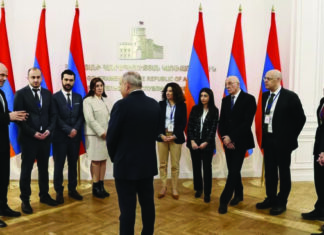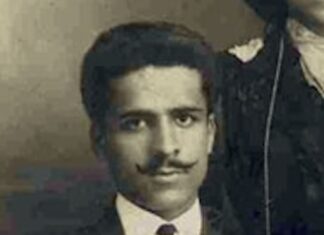By Walter Kalaidjian
For a century, the Armenian Genocide has remained an indelible black mark on the ledger of modernity. The systematic murder of over one million Armenians perpetrated by Ottoman Turkish authorities during World War I bequeathed a legacy of trauma whose delayed recognition has unfolded only gradually. In the classic formula of post-traumatic stress disorder (PTSD), the shock of an initiating event inaugurates but fails to contain or resolve all of its repercussions. The trauma of genocide stretches out over time to possess victims, bystanders, and perpetrators through a pattern of latency and repetition.
In the Armenian case, however, the symptoms of historical trauma are particularly acute and persist owing to Turkey’s longstanding campaign of state-sponsored genocide denial. For Jean Baudrillard, the post-trauma of Armenian genocide denial became a defining instance of the postmodern condition generally, marked as it is by the erosion of historical certainty: “We are like the Armenians,” he wryly noted in his 1990 essay “Necrospective,” “who wear themselves out trying to prove that they were massacred […] a proof that is unattainable, useless, yet in some sense vital.” More recently, on the occasion of the genocide’s centenary of 1915, Pope Francis cited the Armenian case as “the first genocide of the 20th century.” Moreover, he added, in a pointed allusion to Turkey’s ongoing genocide denial, that “concealing or denying evil is like allowing a wound to keep bleeding without bandaging it.”
At the centenary of the event last year, four books — two histories and two memoirs — revisit the scene of the Armenian genocide, bearing witness to its aftermath as it troubles our own moment. The journalist and historian Vicken Cheterian’s Open Wounds: Armenians, Turks, and a Century of Genocide adopts a rhetorical figure similar to the Pope’s as the title for its rigorous, historical study of genocide denial. Cheterian examines genocide’s aftereffects as they have befallen millions of Armenians both in diasporic communities around the globe and in the homelands of Turkey, Armenia, and Nagorno-Karabakh. Similarly, Meline Toumani’s memoir There Was and There Was Not plays on the well-known formula that begins Armenian folk tales ( Gar u chgar) to suggest the ways in which memory denied and deferred unsettles historical certainty. In contrast to Cheterian, Toumani offers an intimate, autobiographical witnessing to the pathology of genocide denial as it upends archival records, thwarts recognition and restitution, and thereby frustrates the process of communal healing in the public sphere.
Reading Cheterian’s historical study against Toumani’s personal memoir makes for a provocative case study of the vicissitudes in narrating the Armenian genocide and its aftermath. Not surprisingly, both Cheterian and Toumani recount many of the same characters, events, and scenes that have, for many Armenians and scholars of Turkish genocide denial, become the well-worn Stations of the Cross. For example, both Cheterian and Toumani discuss Turkey’s erasure of Armenian cultural sites, place names, and property rights with particular attention to the UNESCO protected status of Akhtamar’s Cathedral of the Holy Cross and the compromised plot to restore it as a secular museum in 2007. Notably, among several other similarities, both revisit the controversy surrounding Sabiha Gokcen, the iconic Turkish aviator and namesake of the Istanbul’s Sabiha Gokcen International Airport, who in 2007 was revealed to be the adopted Armenian daughter of Mustafa Kemal Ataturk, founder of the modern Turkish republic. Finally, both Cheterian and Toumani examine Hillary Clinton’s failed 2009 diplomatic efforts to help Turkey and Armenia reach a bilateral accord.
Putting the two works into conversation, however, reveals telling differences in approach, political emphasis, and personal encounter. Unlike Cheterian, who offers a fairly straightforward historical account, Toumani filters her personal narrative through a decidedly subjective lens. She begins with her childhood anxieties of attending summers at Camp Haiastan, founded by the Armenian Youth Federation and Armenian Revolutionary Federation (ARF) that together make up the Hay Heghapokhagan Dashnaktsutyun (the Dashnak Party). There, she is exposed to an obsessive regimen of Armenian nationalism, genocide commemoration, and restitution demands. This strong agenda would lead her, paradoxically enough, to eschew the diasporic politics of genocide recognition. “To me,” she writes, recognition “came to mean that I could no longer stand to attend any Armenian gathering, because it seemed that whether it was a poetry reading, a concert, or even a sporting match, it was always, ultimately, about the genocide.” In a 2014 article in The Nation she argued that Armenians’ “obsession with 1915 was destroying us. Emotional logic seemed feeble; I thought I needed geopolitics to make the case. But the case, at its heart, was emotional.” In a subsequent New York Times piece on Gomidas, the Armenian musician and traumatized survivor of the events of 1915, the word “genocide” does not appear. “In truth,” she writes, “the choice was mine […] Genocide sounds clinical, like the textbook name for a chemical compound or a disease. […] Genocide sounds like lobbying and politics.”








